- ▶
- Heaters/Source
- ▶
- Agilent Heaters and SensorsMass Spectrometry, Scientific Supplies & ManufacturingScientific Instrument Services 5973 Source Heater Tamper Resistant Allen Wrench 5973/5975 Quad Sensor 5985 Source Heater Assembly Agilent Interface Heater Assembly 5971 Interface Heater

- ▶
- LiteratureApplication Notes Adsorbent Resins Guide Mass Spec Tips SDS Sheets FAQ MS Calibration Compound Spectra Manuals MS Links/Labs/ Organizations MS Online Tools Flyers on Products/Services Scientific Supplies Catalog About Us NextAdvance Bullet Blender® Homogenizer Protocols Micro-Mesh® Literature Instrumentation Literature Agilent GC/MS Literature SIS News / E-Mail Newsletter NIST MS Database - Update Notifications

- ▶
- Application NotesNote 103: EPA Method 325B, Novel Thermal Desorption Instrument Modification to Improve Sensitivity Note 102: Identification of Contaminants in Powdered Beverages by Direct Extraction Thermal Desorption GC/MS Note 101: Identification of Contaminants in Powdered Foods by Direct Extraction Thermal Desorption GC/MS Note 100: Volatile and Semi-Volatile Profile Comparison of Whole Versus Cracked Versus Dry Homogenized Barley Grains by Direct Thermal Extraction Note 99: Volatile and Semi-Volatile Profile Comparison of Whole vs. Dry Homogenized Wheat, Rye and Barley Grains by Direct Thermal Extraction GC/MS Note 98: Flavor and Aroma Profiles of Truffle Oils by Thermal Desorption GC/MS Note 97: Flavor Profiles of Imported and Domestic Beers by Purge & Trap Thermal Desorption GC/MS Note 96: Reducing Warping in Mass Spectrometer Filaments, with SISAlloy® Yttria/Rhenium Filaments Note 95: Detection of Explosives on Clothing Material by Direct and AirSampling Thermal Desorption GC/MS Note 94: Detection of Nepetalactone in the Nepeta Cataria Plant by Thermal Desorption GC/MS Note 93: Detection of Benzene in Carbonated Beverages with Purge & Trap Thermal Desorption GC/MS Note 92: Yttria Coated Mass Spectrometer Filaments Note 91: AutoProbe DEP Probe Tip Temperatures Note 90: An Automated MS Direct Probe for use in an Open Access Environment Note 89: Quantitation of Organics via a Mass Spectrometer Automated Direct Probe Note 88: Analysis of Silicone Contaminants on Electronic Components by Thermal Desorption GC-MS Note 87: Design and Development of an Automated Direct Probe for a Mass Spectrometer Note 86: Simulation of a Unique Cylindrical Quadrupole Mass Analyzer Using SIMION 7.0. Note 85: Replacing an Electron Multiplier in the Agilent (HP) 5973 MSD Note 84: Vacuum Pump Exhaust Filters - Charcoal Exhaust Traps Note 83: Vacuum Pump Exhaust Filters - Oil Mist Eliminators Note 82: Vacuum Pump Exhaust Filters Note 81: Rapid Bacterial Chemotaxonomy By DirectProbe/MSD Note 80: Design, Development and Testing of a Microprocessor ControlledAutomated Short Path Thermal Desorption Apparatus Note 79: Volatile Organic Compounds From Electron Beam Cured and Partially Electron Beam Cured Packaging Using Automated Short Path Thermal Desorption Note 78: A New Solution to Eliminate MS Down-Time With No-Tool-Changing of Analytical GC Columns Note 77: The Determination of Volatile Organic Compounds in VacuumSystem Components Note 76: Determination of the Sensitivity of a CRIMS System Note 75: An Apparatus for Sampling Volatile Organics From LivePlant Material Using Short Path Thermal Desorption Note 74: Examination of Source Design in Electrospray-TOF Using SIMION 3D Note 73: The Analysis of Perfumes and their Effect on Indoor Air Pollution Note 72: 1998 Version of the NIST/EPA/NIH Mass Spectral Library, NIST98 Note 71: Flavor Profile Determination of Rice Samples Using Shor tPath Thermal Desorption GC Methods Note 70: Application of SIMION 6.0 To a Study of the Finkelstein Ion Source: Part II Note 69: Application of SIMION 6.0 To a Study of the Finkelstein Ion Source: Part 1 Note 68: Use of a PC Plug-In UV-Vis Spectrometer To Monitor the Plasma Conditions In GC-CRIMS Note 67: Using Chemical Reaction Interface Mass Spectrometry (CRIMS) To Monitor Bacterial Transport In In Situ Bioremediation Note 66: Probe Tip Design For the Optimization of Direct Insertion Probe Performance Note 65: Determination of Ethylene by Adsorbent Trapping and Thermal Desorption - Gas Chromatography Note 64: Comparison of Various GC/MS Techniques For the Analysis of Black Pepper (Piper Nigrum) Note 63: Determination of Volatile and Semi-Volatile Organics in Printer Toners Using Thermal Desorption GC Techniques Note 62: Analysis of Polymer Samples Using a Direct Insertion Probe and EI Ionization Note 61: Analysis of Sugars Via a New DEP Probe Tip For Use With theDirect Probe On the HP5973 MSD Note 60: Programmable Temperature Ramping of Samples Analyzed ViaDirect Thermal Extraction GC/MS Note 59: Computer Modeling of a TOF Reflectron With Gridless Reflector Using SIMION 3D Note 58: Direct Probe Analysis and Identification of Multicomponent Pharmaceutical Samples via Electron Impact MS Note 57: Aroma Profiles of Lavandula species Note 56: Mass Spec Maintenance & Cleaning Utilizing Micro-Mesh® Abrasive Sheets Note 55: Seasonal Variation in Flower Volatiles Note 54: Identification of Volatile Organic Compounds in Office Products Note 53: SIMION 3D v6.0 Ion Optics Simulation Software Note 52: Computer Modeling of Ion Optics in Time-of-Flight mass Spectrometry Using SIMION 3D Note 51: Development and Characterization of a New Chemical Reaction Interface for the Detection of Nonradioisotopically Labeled Analytes Using Mass Spectrometry (CRIMS) Note 50: The Analysis of Multiple Component Drug Samples Using a Direct Probe Interfaced to the HP 5973 MSD Note 49: Analysis of Cocaine Utilizing a New Direct Insertion Probe on a Hewlett Packard 5973 MSD Note 48: Demonstration of Sensitivity Levels For the Detection of Caffeine Using a New Direct Probe and Inlet for the HP 5973 MSD Note 47: The Application Of SIMION 6.0 To Problems In Time-of-Flight Mass Spectrometry Note 46: Delayed Extraction and Laser Desorption: Time-lag Focusing and Beyond Note 45: Application of SIMION 6.0 to Filament Design for Mass Spectrometer Ionization Sources Note 44: The Design Of a New Direct Probe Inlet For a Mass Spectrometer Note 43: Volatile Organic Composition In Blueberries Note 42: The Influence of Pump Oil Purity on Roughing Pumps Note 41: Hydrocarbon Production in Pine by Direct Thermal Extraction Note 40: Comparison of Septa by Direct Thermal Extraction Note 39: Comparison of Sensitivity Of Headspace GC, Purge and Trap Thermal Desorption and Direct Thermal Extraction Techniques For Volatile Organics Note 38: A New Micro Cryo-Trap For Trapping Of Volatiles At the Front Of a GC Capillary Column Note 37: Volatile Organic Emissions from Automobile Tires Note 36: Identification Of Volatile Organic Compounds In a New Automobile Note 35: Volatile Organics Composition of Cranberries Note 34: Selection Of Thermal Desorption and Cryo-Trap Parameters In the Analysis Of Teas Note 33: Changes in Volatile Organic Composition in Milk Over Time Note 32: Selection and Use of Adsorbent Resins for Purge and Trap Thermal Desorption Applications Note 31: Volatile Organic Composition in Several Cultivars of Peaches Note 30: Comparison Of Cooking Oils By Direct Thermal Extraction and Purge and Trap GC/MS Note 29: Analysis Of Volatile Organics In Oil Base Paints By Automated Headspace Sampling and GC Cryo-Focusing Note 28: Analysis Of Volatile Organics In Latex Paints By Automated Headspace Sampling and GC Cryo-Focusing Note 27: Analysis of Volatile Organics In Soils By Automated Headspace GC Note 26: Volatile Organics Present in Recycled Air Aboard a Commercial Airliner Note 25: Flavor and Aroma in Natural Bee Honey Note 24: Selection of GC Guard Columns For Use With the GC Cryo-Trap Note 23: Frangrance Qualities in Colognes Note 22: Comparison Of Volatile Compounds In Latex Paints Note 21: Detection and Identification Of Volatile and Semi-Volatile Organics In Synthetic Polymers Used In Food and Pharmaceutical Packaging Note 20: Using Direct Thermal Desorption to Assess the Potential Pool of Styrene and 4-Phenylcyclohexene In Latex-Backed Carpets Note 19: A New Programmable Cryo-Cooling/Heating Trap for the Cryo-Focusing of Volatiles and Semi-Volatiles at the Head of GC Capillary Columns Note 18: Determination of Volatile Organic Compounds In Mushrooms Note 17: Identification of Volatile Organics in Wines Over Time Note 16: Analysis of Indoor Air and Sources of Indoor Air Contamination by Thermal Desorption Note 14: Identification of Volatiles and Semi-Volatiles In Carbonated Colas Note 13: Identification and Quantification of Semi-Volatiles In Soil Using Direct Thermal Desorption Note 12: Identification of the Volatile and Semi-Volatile Organics In Chewing Gums By Direct Thermal Desorption Note 11: Flavor/Fragrance Profiles of Instant and Ground Coffees By Short Path Thermal Desorption Note 10: Quantification of Naphthalene In a Contaminated Pharmaceutical Product By Short Path Thermal Desorption Note 9: Methodologies For the Quantification Of Purge and Trap Thermal Desorption and Direct Thermal Desorption Analyses Note 8: Detection of Volatile Organic Compounds In Liquids Utilizing the Short Path Thermal Desorption System Note 7: Chemical Residue Analysis of Pharmaceuticals Using The Short Path Thermal Desorption System Note 6: Direct Thermal Analysis of Plastic Food Wraps Using the Short Path Thermal Desorption System Note 5: Direct Thermal Analysis Using the Short Path Thermal Desorption System Note 4: Direct Analysis of Spices and Coffee Note 3: Indoor Air Pollution Note 2: Detection of Arson Accelerants Using Dynamic Headspace with Tenax® Cartridges Thermal Desorption and Cryofocusing Note 1: Determination of Off-Odors and Other Volatile Organics In Food Packaging Films By Direct Thermal Analysis-GC-MS Tech No. "A" Note 14: Elimination of "Memory" Peaks in Thermal Desorption Improving Sensitivity in the H.P. 5971 MSD and Other Mass Spectrometers - Part I of II Improving Sensitivity in the H.P. 5971 MSD and Other Mass Spectrometers- Part II of II Adsorbent Resins Guide Development and Field Tests of an Automated Pyrolysis Insert for Gas Chromatography. Hydrocarbon Production in Pine by Direct Thermal Extraction A New Micro Cryo-Trap for the Trapping of Volatiles at the Front of a GC Capillary (019P) - Comparison of Septa by Direct Thermal Extraction Volatile Organic Composition in Blueberry Identification of Volatile Organic Compounds in Office Products Detection and Indentification of Volatiles in Oil Base Paintsby Headspace GC with On Column Cryo-Trapping Evaluation of Septa Using a Direct Thermal Extraction Technique INFLUENCE OF STORAGE ON BLUEBERRY VOLATILES Selection of Thermal Desorption and Cryo-Trap Parameters in the Analysis of Teas Redesign and Performance of a Diffusion Based Solvent Removal Interface for LC/MS The Design of a New Direct Probe Inlet for a Mass Spectrometer Analytes Using Mass Spectrometry (CRIMS) Application of SIMION 6.0 to Filament Design for Mass Spectrometer Ionization Sources A Student Guide for SIMION Modeling Software Application of SIMION 6.0 to Problems in Time-of-flight Mass Spectrometry Comparison of Sensitivity of Headspace GC, Purge and TrapThermal Desorption and Direct Thermal Extraction Techniques forVolatile Organics The Influence of Pump Oil Purity on Roughing Pumps Analysis of Motor Oils Using Thermal Desorption-Gas Chromatography-Mass Spectrometry IDENTIFICATION OF VOLATILE ORGANIC COMPOUNDS IN PAPER PRODUCTS Computer Modeling of Ion Optics in Time-of-Flight mass Spectrometry using SIMION 3D Seasonal Variation in Flower Volatiles Development of and Automated Microprocessor Controlled Gas chromatograph Fraction Collector / Olfactometer Delayed Extraction and Laser Desorption: Time-lag Focusing and Beyond A New Micro Cryo-Trap for the Trapping of Volatiles at the Front of a GC Column Design of a Microprocessor Controlled Short Path Thermal Desorption Autosampler Computer Modeling of Ion Optics in Time-of-Flight Mass Spectrometry Using SIMION 3D Thermal Desorption Instrumentation for Characterization of Odors and Flavors

- ▶
- Note 78: A New Solution to Eliminate MS Down-Time With No-Tool-Changing of Analytical GC Columns (This Page)
By Hans T. Cornet and Hans T. Cornet, SGT Middelburg B.V., Arnesteinweg 23A tel. : +31 118 623095, P.O. Box 8027, NL-4330 EA Middelburg, Netherlands www.sgt-nl.com fax : +31 118 639536, E-mail: sgtnl@wxs.nl
Presented at PittCon 99, Orlando, FL, March 1999.
INTRODUCTION
The Mass Spectrometric Detector (MS Detector) is a unique GC detector because it operates in a vacuum. Unlike for conventional GC detectors and differentially pumped mass spectrometers, changing the GC column on singly pumped benchtop MS usually requires GC/MS shut down procedure that allows the MS to cool down and vent. After column installation, pump down procedure is applied and it takes more than four hours (usually overnight) until MS is in a stable vacuum and ready for analysis.
SGT's new and patented MS-Interface Kit makes the GC column exchange user-friendly and totally eliminates switching-off benchtop MS.
Description
In order to achieve a connection between the analytical capillary column and the MS detector, avoiding the necessity of switching-off the MS detector when columns and/or injector liners need to be changed, the SGT MS-Interface Kit (M.I.K.), as shown in Picture 1 and 2, is designed to interface the column and theMS detector.
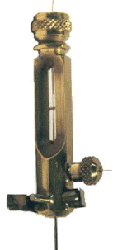
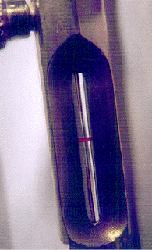
The capillary column is no longer physically connected to the MS detector but to the M.I.K. The M.I.K. is connected to the MS detector using uncoated fused-silica tubing (column extension) of a specific inner diameter. The connection between the capillary column and the column extension is made using a glass press-fit connector.
But!
Press-Fit Connectors have a bad namend a questionable reputation. The mean two reasons of leaking connections and fused-silica sticking in regular press-fit connections are badly cutted columns (irregular column surfaces e.d.) and the fact that too much or too little forced is used to make a proper, leaktight connection in a press-fit connector.

How are these two problems solved in the MS-Interface Kit?
Problem 1 : Bad Column Cuts
The problem of the bad and irregular column cuts is solved by using the SGT Shortix™ and Shortix™ Plus Capillary Column Cutters for making proper and clean cuts.

Shortix™ and Shortix™ Plus
Problem 2 : Amount of Force for Proper Connection
The problem of the amount of force used to make a proper column/press-fit connection is solved by using spring pressure at the top of the press-fit connector. When a column is pushed into the press-fit in the M.I.K., the special spring at the top of the press-fit regulates the amount of force needed to make the connection. It is now practically impossible to use too much, or too little force. A leaktight connection now can be made by every user of the M.I.K Therefore the SGT MS-Interface has been made 'SELF-COMPENSATING'
Working Principle of MIK Column Installed
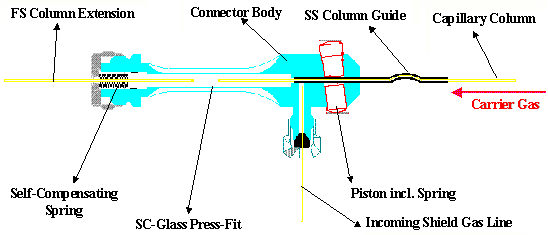
Via a SS-Column Guide the analytical capillary column is connected to the SC-Glass Press-Fit inside the M.I.K. From the Press-Fit a piece of uncoated fused-silica is connected into the MS-Detector. The force needed to make a proper, leaktight connection of the column into the Press-Fit is regulated by the 'Self-Compensating Spring' at the top of the Press-Fit. This spring precisely regulates the force with which the column is connected into the Press-Fit. A repeatable, clean, leaktight and No-Tool-Needed connection is the result
Working Principle of MIK Column NOT Installed
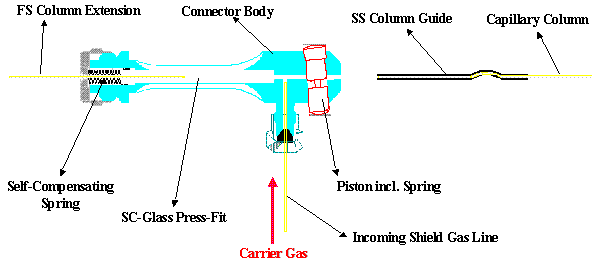
By pushing the Piston, the column and SS-Column Guide can be removed from the MS-Interface Connector, leaving a clean and re-usable Press-Fit. By switching a valve, clean carriergas enters the MIK through the Shield-Gas side inlet while the Piston closes the MS-Interface, protecting it from air. The MS-Detector stays On-Line because of the incoming Shield-Gas. When a new column is installed, the Shield-Gas is taken off the system and a new analysis can be performed SECONDS AFTER INSTALLATION OF THE COLUMN!
Experimental
All analysis were performed by using an HP 5973 Mass Selective Detector coupled to an HP 6890 Series Gas Chromatograph. The GC was equipped with split/splitless injector with Electronic Pressure Control (EPC). A major advantage of EPC in conjunction with the MSD is the constant flow mode. The column head pressure is adjusted to track the temperature of the GC oven so that the volume of carrier gas reaching the ion source is constant. This constant source pressure then results in improved reproducibility of the mass spectra produced by the MSD. This and other features of EPC are described in detail in several publications1 . Injection was performed in splitless mode using a HP 7673 automatic sampler. The instrument configuration and analytical conditions are summarized in Table 1.
Table 1. Experimental Conditions
For Analysis of Polynuclear Aromatic Hydrocarbons (PAH)
| Gas Chromatograph | |
| Column: | 30m x 0.25mm x 0.25µm HP-5MS |
| Inlet: | Split/splitless |
| Injection: | 1µl; HP 7673 Automatic Liquid Sampler (ALS) |
| Inlet temp: | 325°C |
| Inlet press: | 9.44 psi at 60°C; 39 cm/sec with He carrier, 1.1 ml/min, Constant Flow Mode |
| MSD Transfer Line: | 320°C |
| Temperature Program: | 60°C (2 min), 25°C/min to 160°C (0 min) ,3°C/min to 300°C (0 min), 25°C/min to 325°C (1 min) |
| MS Quad: | 150°C |
| MS Source: | 230°C |
| Scan: | 10 - 280 |
| EM Voltage: | 1506 |
| Test mixture: | 16 EPA Polyaromatic hydrocarbons 610-M diluted in cyclohexan for final concentrations in the range from 20 - 1ng/µl |
Regular GC/MSD Leak-Check
There are two ways to check for leaks in an GC column when it is hooked up to a MSD. For gross helium leaks, a helium detector can be used on its high sensitivity setting2. Air leaks into the connection will not register on the helium leak detector, but will be seen by the MS. Once there are no detectable helium leaks, the MSD can be used to check for small leaks. By going into the diagnostics/vacuum control, the edit MSD parameter's screen can be displayed. By clicking on more parameters, acquisition masses can be changed to 69, 18 and 28. With the PFTBA valve open, a spectrum can be obtained in the scan range from 10 -80 a.m.u. If ions at m/z 28 and 32 for N2 and O2 are present with no corresponding m/z =18 for H2O then there is a leak in a system. Figure 2 shows a PFTBA spectrum from a leak-free system (example with direct GC column connection).
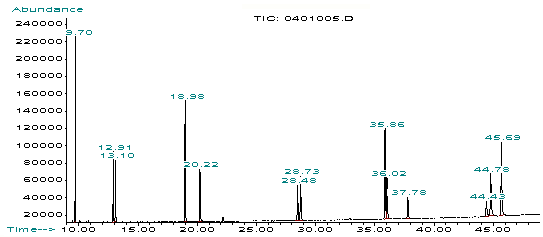
Figure 1. Analysis of 16 PAH's with new GC column connected to the mass spectrometer through an interface that is sealed with column nut and ferrule (direct connection) is shown.
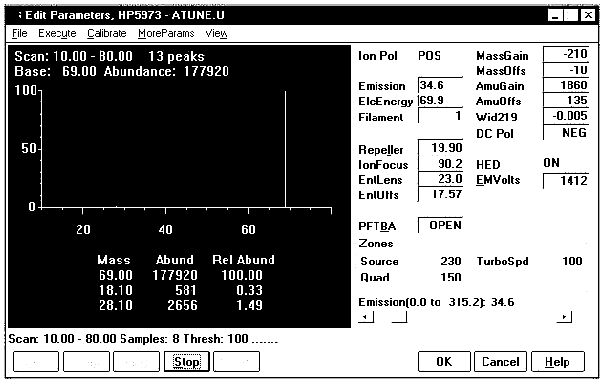
Figure 2. A spectrum of PFTBA from a leak free system. Notice that m/z=28 is 1.49 % of m/z = 69 and the water (m/z = 18) is only 0.33%
Comparison of PAH Analysis With and Without MS-Interface
Figure 3 shows that peak shape and responses are identical with and without MS-Interface Kit and due to the additional 1m transfer line retention times are shifted for 20-30 sec. Recently introduced Retention Time Locking (RTL) can be useful in reproducing the original retention time of a compound after column maintenance. 3,4
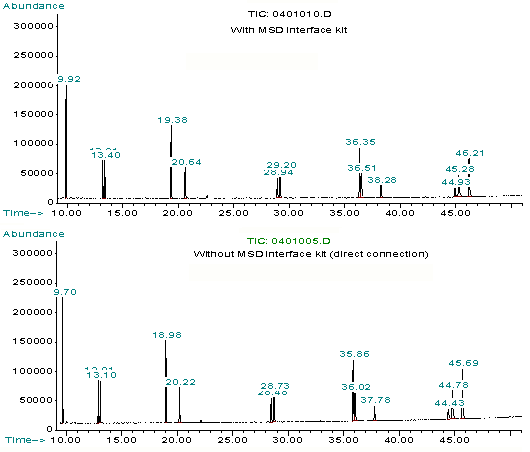
Figure 3. Analysis of PAH's With and Without MS-Interface Kit (M.I.K.)
Influence of Column Change On Air Diffusion in MS
Following example demonstrate how easy and quick column can be changed when M.I.K. is already installed. There is no need to vent the MSD when column has to be replaced (maintained). Figure 4 shows the leak at the moment when the column is removed from the new M.I.K.
Just 10 sec later when new column is in place, the vacuum has been already back and Air & Water check test passed (figure 5).
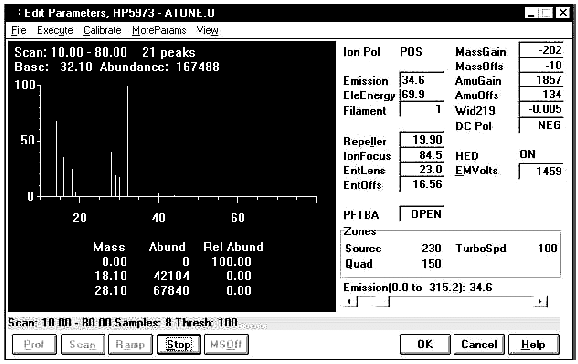
Figure 4. A spectrum of PFTBA From a System With a Leak. There is no GC column in place!
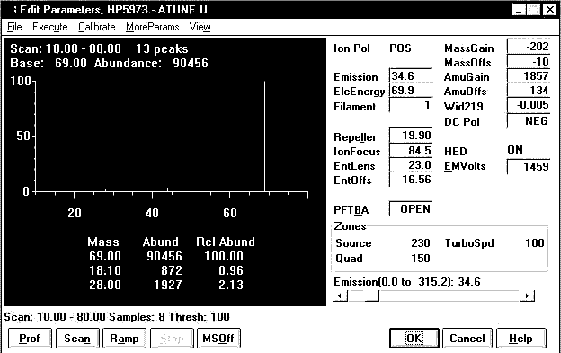
Figure 5. A spectrum of PFTBA from a leak free system just 10 seconds later when the column is already connected! Notice that m/z=28 is 2.13% of m/z=69 and the water (m/z) is 0.96%.
As can be seen from overlaid chromatograms (n=11) shown on figure 6 and 7, analysis of 16 EPA Polyaromatic hydrocarbons is showing even better baseline stability when using the new SGT M.I.K. compared to direct GC column connection. This example clearly demonstrates advantages of quick GC column exchange without switching-off the Mass Spectrometric Detector as the vacuum system is stable within a minutes and MSD is ready for multiple analysis.
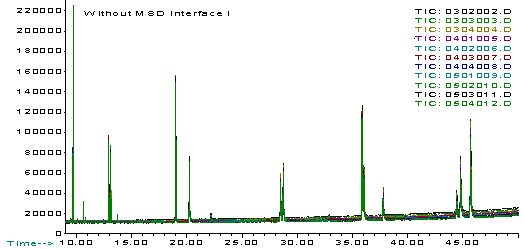
Figure 6. Analysis of 16 EPA PAH's By GC/MSD Using Standard Direct Column Connection
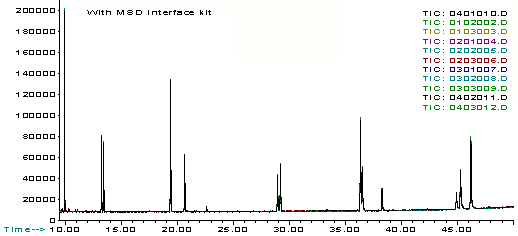
Figure 7. Analysis of 16 EPA PAH's By GC/MSD Using M.I.K
Conclusions
The use of the MS-Interface Kit offers some important advantages for benchtop MS users. Using an MS-Interface Kit a GC column can be exchanged within the minutes instead of waiting for hours to cool-down, vent and pump down the MS. The MS-Interface Kit not only provides quick column exchange,it also allows the MS to remain hot in stable vacuum and be ready for routine analysis. After installation, a MS-Interface Kit does not require any ferrules, column nuts or tools for column installations . Using the MS-Interface increases baseline stability.

